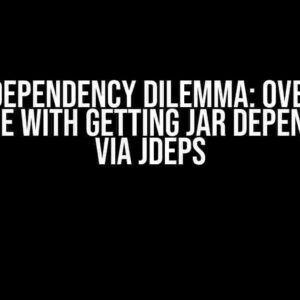As developers, we’ve all been there – stuck in a tangled web of dependencies, wondering how to elegantly manage the complexity of our application’s architecture. That’s where Dependency Injection (DI) comes to the rescue! In this article, we’ll delve into the world of DI and explore the power of the implementationFactory, focusing on its usage with related services.
What is Dependency Injection?
Before we dive into the nitty-gritty of implementationFactory, let’s quickly recap what Dependency Injection is and why it’s essential in modern software development.
Dependency Injection is a design pattern that allows components to be loosely coupled, making it easier to test, maintain, and extend our application. The core idea is to decouple objects from their dependencies, instead providing them through a third-party mechanism. This way, components can focus on their primary responsibilities, rather than being bogged down by dependencies.
Why Use Dependency Injection?
The benefits of DI are numerous:
- Loose Coupling: Components are no longer tightly coupled to specific implementations, making it easier to swap out dependencies or modify the system.
- Testability: DI makes it easier to write unit tests, as dependencies can be easily mocked or stubbed.
- Flexibility: DI enables greater flexibility in the system, as components can be easily replaced or updated without affecting the entire application.
- Scalability: By decoupling components, DI allows for more efficient and scalable system design.
What is an Implementation Factory?
An implementation factory is a crucial concept in Dependency Injection, which provides a way to create instances of dependent objects. In essence, it’s a factory that returns an implementation of a specific interface or abstract class.
The implementation factory is responsible for:
- Creating instances of dependent objects.
- Resolving dependencies between components.
- Providing a way to switch between different implementations of the same interface.
How Does an Implementation Factory Work?
Let’s take a closer look at how an implementation factory works:
// Assume we have an interface called Logger
public interface Logger {
void log(String message);
}
// We have two implementations of the Logger interface
public class ConsoleLogger implements Logger {
@Override
public void log(String message) {
System.out.println(message);
}
}
public class FileLogger implements Logger {
@Override
public void log(String message) {
// Log to a file
}
}
// Now, let's create an implementation factory for the Logger interface
public class LoggerFactory {
public static Logger createLogger(boolean useConsole) {
if (useConsole) {
return new ConsoleLogger();
} else {
return new FileLogger();
}
}
}
In this example, the `LoggerFactory` is responsible for creating instances of `Logger` implementations based on the `useConsole` parameter. This allows us to easily switch between different logging mechanisms.
Using Implementation Factory with Related Services
Now that we’ve covered the basics of implementation factories, let’s explore how to use them with related services.
Scenario: User Service with Multiple Dependencies
Imagine we have a `UserService` that depends on multiple services, such as a `DatabaseService` and a `CacheService`. We want to use an implementation factory to provide instances of these services to the `UserService`.
// UserService interface
public interface UserService {
User getByUsername(String username);
}
// DatabaseService implementation
public class DatabaseService implements UserService {
@Override
public User getByUsername(String username) {
// Retrieve user from database
}
}
// CacheService implementation
public class CacheService implements UserService {
@Override
public User getByUsername(String username) {
// Retrieve user from cache
}
}
// Implementation factory for UserService
public class UserServiceFactory {
public static UserService createUserServiceProvider(boolean useDatabase) {
if (useDatabase) {
return new DatabaseService();
} else {
return new CacheService();
}
}
}
In this scenario, the `UserServiceFactory` provides instances of `UserService` implementations based on the `useDatabase` parameter. This allows us to switch between using the database or cache service for user retrieval.
Benefits of Using Implementation Factory with Related Services
The benefits of using implementation factories with related services are numerous:
- Decoupling: Implementation factories help to decouple components from specific implementations, making it easier to test and maintain the system.
- Flexibility: By providing a way to switch between different implementations, implementation factories enable greater flexibility in the system.
- Reusability: Implementation factories promote reusability of code, as components can be easily reused in different contexts.
Best Practices for Using Implementation Factory with Related Services
When using implementation factories with related services, keep the following best practices in mind:
-
Keep the implementation factory simple and focused on creating instances of dependent objects.
-
Avoid tightly coupling the implementation factory to specific implementations.
-
Use interfaces and abstraction to decouple components from specific implementations.
-
Document the implementation factory and its usage clearly, so that other developers can easily understand the system.
Conclusion
In this article, we’ve explored the power of implementation factories in Dependency Injection, focusing on their usage with related services. By mastering the implementation factory pattern, you’ll be able to write more maintainable, flexible, and scalable code.
Remember, the key to successful Dependency Injection is to keep components loosely coupled and focused on their primary responsibilities. By using implementation factories, you can ensure that your system remains modular, testable, and easy to maintain.
Additional Resources
For further learning, be sure to check out:
| Keyword | Definition |
|---|---|
| Dependency Injection | A design pattern that allows components to be loosely coupled, making it easier to test, maintain, and extend the system. |
| Implementation Factory | A factory that returns an implementation of a specific interface or abstract class. |
By following the principles and best practices outlined in this article, you’ll be well on your way to becoming a master of Dependency Injection and implementation factories. Happy coding!
Frequently Asked Question
Get the most out of your Dependency Injection with implementationFactory and related services.
What is the purpose of implementationFactory in Dependency Injection?
The implementationFactory is a powerful tool in Dependency Injection that allows you to create instances of services at runtime, giving you more control over the creation process. It’s particularly useful when you need to inject services that have complex dependencies or when you want to decouple the service creation from the application logic.
How do I use implementationFactory with related services?
To use implementationFactory with related services, you need to define the factory method that creates the instance of the service. Then, you can inject the related services into the factory method, and use them to create the instance of the service. For example, if you have a service that depends on a database connection, you can inject the database connection service into the factory method and use it to create the instance of the service.
What are the benefits of using implementationFactory with related services?
Using implementationFactory with related services provides several benefits, including loose coupling, testability, and flexibility. It allows you to decouple the service creation from the application logic, making it easier to test and maintain. It also provides more flexibility in terms of service creation, as you can create instances of services at runtime based on specific conditions.
Can I use implementationFactory with multiple related services?
Yes, you can use implementationFactory with multiple related services. In fact, one of the main advantages of implementationFactory is that it allows you to inject multiple services into the factory method, making it easy to create instances of services that depend on multiple dependencies.
What are some common use cases for implementationFactory with related services?
Some common use cases for implementationFactory with related services include creating instances of services that depend on database connections, file systems, or network resources. It’s also commonly used in scenarios where you need to create instances of services based on specific conditions, such as user roles or permissions.


